Whether you’re an experienced forager or just starting out, the Alaskan wilderness is an amazing place to look for edible berries. This large state, often referred to as the “Last Frontier”, is a paradise for outdoor enthusiasts and wild food foragers. People experience nature here while standing on a mountain top or in a field of Alaskan wildflowers. These memorable outdoor experiences can easily be paired with the search for Alaskan berries. There are many types of berries to be found. Read our guide to discover 13 different edible plants to look for and the poisonous Alaska berries you’ll need to avoid.
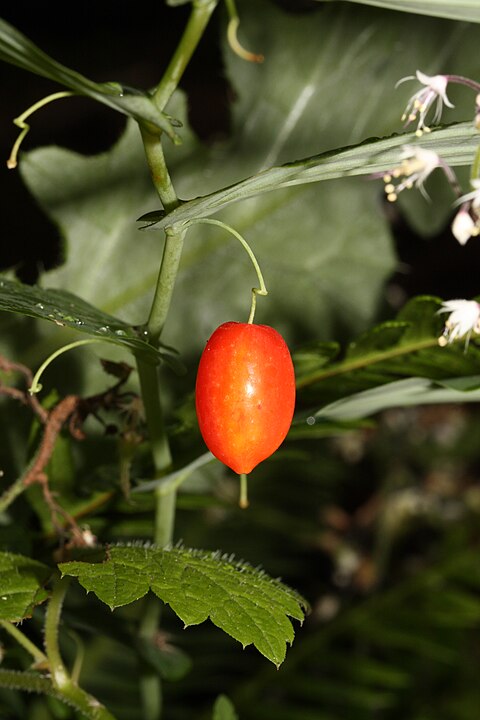
1. Watermelon Berries
You can find watermelon berries (Streptopus amplexifolius) across southern Alaska. Their taste is mildly sweet and tangy, and it’s easy to see the comparison to the watermelon flavor. It’s there, if not very strong. The skins on the berry are thin and often have a matte feeling when you touch them, similar to that of blueberries.
Watermelon berries are best harvested in the fall, often late September, when these red berries still have tight skin and are plump with juice. Be aware that these berries are full of seeds. If you eat too many watermelon berries, you may develop diarrhea or other stomach pains, so only eat a small handful of these at a time after you’ve correctly identified them. Many people save the berries and use them to make jams, though seeding them is extra work.

2. Highbush Cranberry
Hanging out with other foragers in Alaska, you may hear people say “mooseberry” or “squashberry”. When they do, they’re talking about the edible berries known as highbush cranberries. The shrubs, often with red leaves, will have clusters of translucent red berries. They can be found in damp woods and along streambanks, particularly in southcentral Alaska and in the vicinity of Denali National Park. Late August through late September is the ideal berry-picking season for these gems, which can be used to make jams, jellies, and even fruit leather. Their naturally high pectin levels mean you won’t need to add pectin to the recipe to have a perfect consistency.
It’s important to note that if you’re planning to eat highbush cranberries right off the shrub, they are sometimes hit-and-miss when it comes to flavoring. Sometimes you’ll bite into one, and it’s sweet and delicious and everything you want it to be. The next one you eat from the same handful may be bitter or overwhelmingly tangy. This is another reason many people choose to use this fruit for jams instead of fresh snacking.
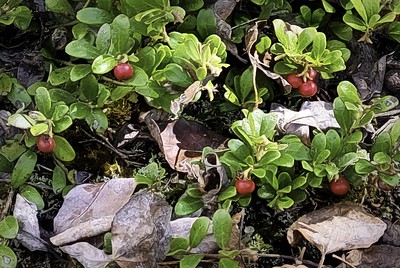
3. Low Bush Cranberries
Lowbush cranberries are delicious right on the trail. These taste more like the commercial berries you think of from your trips to the grocery store. They are also called lingonberries.
These berries are smaller and grow close to the ground, often forming dense patches. Lingonberries are easily recognized by their small, round, red berries that often grow on short evergreen shrubs. They thrive in subarctic regions, making them common in Alaskan landscapes. Lingonberries are known for their tangy flavor and are popular for making jams and sauces. Late August to late September is typically the prime berry picking season for these little red gems.
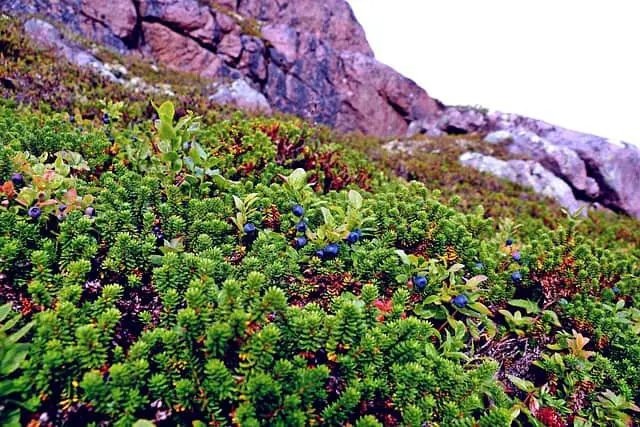
4. Wild Blueberries
Wild blueberries are a favorite amongst berry enthusiasts, offering an intense and sweet flavor. Found in a variety of habitats, including open meadows and forest clearings, these berries are relatively easy to identify thanks to their round shape and deep blue hue and the familiarity that many of us have with them from the grocery store or farmer’s markets. The berry picking season for wild blueberries spans from late July to mid-August, making them a great addition to your summer adventures.

5. Salmon Berries
As their name implies, salmon berries exhibit a range of colors reminiscent of the iconic fish eggs. These large berries can be red, orange, or even yellow and are usually found in moist environments along rivers and streams. Realistically, they look a lot like blackberry or raspberry, only in much brighter colors. Their flavor is too mild for some and just right for others, with a mild sweetness. Harvest them in early August in Alaska for a burst of juicy goodness.
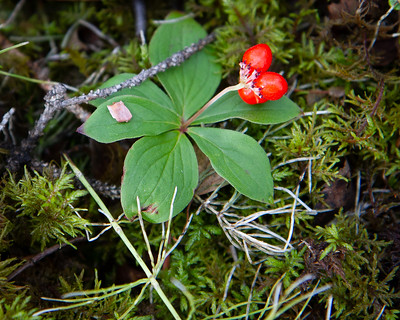
6. Bunchberries
Bunchberries are miniature works of art, with a small cluster of red berries gathered at the center of a rich bunch of green leaves. These berries grow in low, dense mats and are often found in moist, shady areas. Their slightly tart flavor makes them a unique addition to your berry collection. In regions further south on the continent, people harvest bunchberries in mid-summer. Up in Alaska, you’ll find these photogenic berries in early autumn, around September and October.

7. Blue Huckleberry
Blue huckleberries resemble blueberries but tend to be slightly larger and more elongated. They can be found in open forests and meadows, particularly in regions like the Chugach State Park. Late summer is the perfect time to seek out these flavorful berries.
You may have heard that blueberries have particularly high levels of antioxidants, which is true. The domestic blueberry has antioxidant levels of about 42. The blue huckleberry takes this to a whole other level, with antioxidant levels of 111.
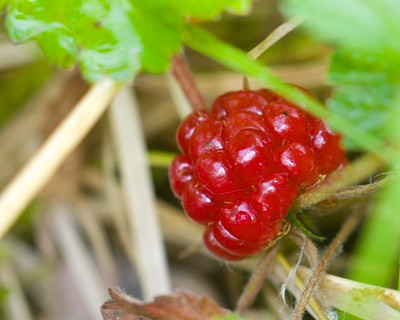
8. Nagoonberry
Nagoonberries are round, dark red, or even purple-ish berries that grow on low shrubs in open forests. They look a lot like a very well-rounded raspberry. These berries are a favorite among Alaskan foragers due to their sweet and slightly tart taste. The best time to harvest nagoonberries is in late July or early August.
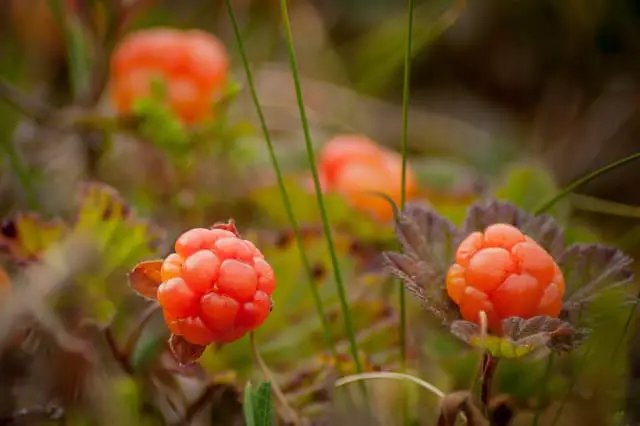
9. Cloudberries
Cloudberries are prized for their unique appearance and delicious taste. These golden berries look like a cross between a raspberry and a strawberry and are often found in wetlands and bogs. Their distinctive flavor makes them a sought-after ingredient for jams and desserts. You can harvest cloudberries in Alaska in August.
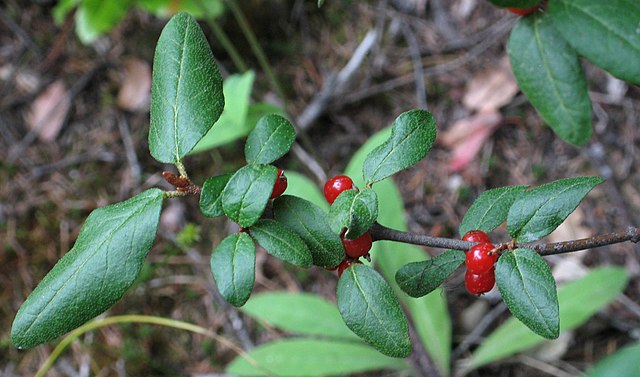
10. Soapberries
Soapberries were traditionally used as medicine. The bark and roots were valued for their medicinal purposes. Soapberries are edible, but they’re not ones that foragers often seek out because their flavor is either mild or bitter. The fruits are red or yellow with translucent skin. They grow in clusters and are typically ripe in the autumn. It’s a good idea to harvest these after the first frost hits because the berries’ flavor really improves to something much sweeter.
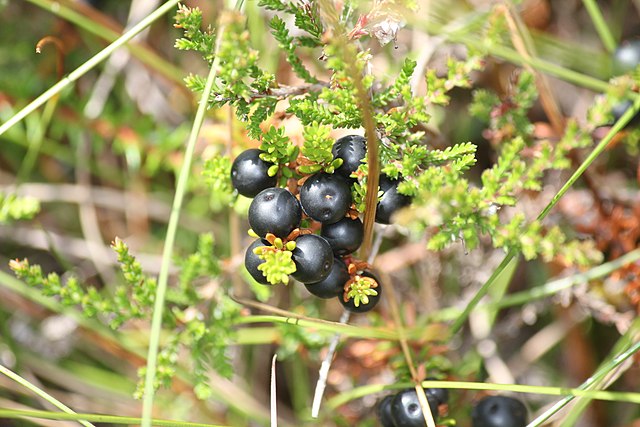
11. Crowberry
Crowberries are small, black berries that grow on low shrubs in tundra and heath habitats. While they may appear similar to blueberries, crowberries have a distinct, more tart flavor. They can be harvested in the early fall and may hang around through the winter. These are another fruit that will taste much sweeter after the first freeze. However, the skin will be thinner after the first freeze, so you’ll need to handle the berries very carefully while harvesting them.

12. Kinnikinnick Berries
Kinnikinnick berries, also known as bearberries, grow on low, trailing shrubs. These berries are red and have a tart taste. They often appear in July or August. The berries may cling to the plant and still be spotted as late as February, depending on the season. They can be found in rocky areas and open forests.

13. Wild Rosehips
Rosehips are an excellent source of vitamin c. These berries are typically red or orange and can be found in a variety of habitats. Harvest them in late summer or early fall for their medicinal and culinary uses.
Watch for Poisonous Alaskan Berries
It’s always a good idea to familiarize yourself with dangerous plants to avoid when you’re foraging. In fact, it’s a good practice to learn more about the dangerous plants in an area before you learn about the edible ones.
In Alaska, there are two good rules to follow. The first is to avoid all white berries. There are enough poisonous white berries in the Alaska region that it’s better to assume they are poisonous and move on.
The other item to avoid while looking for edible berries is the baneberry. This red berry looks a lot like highbush cranberries, which is horrible unfortunate. Baneberries are sometimes white but often red. Baneberries have a black spot on the end. The seeds of a highbush cranberry are an oval that’s been flattened. The baneberry has a crescent-shaped seed.
Be sure to use a field guide and familiarize yourself with baneberries before eating any berries you find in Alaska.
Foraging in the Alaskan Wilderness
When foraging for wild berries in Alaska, it’s important to remember a few key guidelines. Always respect private property and be mindful of the traditional land use of indigenous people. Bring along reliable berry books or guides to help with identification. Berry picking season typically spans from late July to late September, with late August being an especially rewarding time for finding an abundance of fresh berries.
Before setting off on a day hike to discover these natural treasures, familiarize yourself with the leaves of the berries you’re seeking. Accurate identification involves recognizing the foliage, as well as the berries themselves. Some berries have distinctive leaves, while others may have leaves that closely resemble those of other edible plants or Alaskan wildflowers.
Once you’ve located a berry patch, use a shallow container to gently collect the berries, being careful not to bruise or damage them. If you can’t consume them all immediately, consider freezing the berries for later use. The cookie sheet is a great way to store these berries in the freezer, giving them space when you first freeze them. You can also turn your harvest into flavorful fruit leather or jams to preserve the taste of Alaskan summer throughout the year.
Foraging for wild berries in Alaska is not only a great way to connect with nature but also a way to savor the bounty of the land. As you venture through the untamed landscapes of the Last Frontier, these berries are a reminder of the diverse and delicious offerings that nature provides.
Recent Posts
The only venomous snakes in Washington State are Northern Pacific Rattlesnakes. The Northern Pacific Rattlesnake (Crotalus oreganus oreganus) is a sub-species of the Western Rattlesnake. Anyone...
Skunks are not classified as true hibernators. But they go into a state of torpor when the weather gets cold. Skunks are light sleep hibernators, along with opossums, bears, and raccoons. ...
